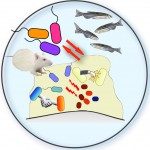Lien vers Pubmed [PMID] – 23667443
PLoS ONE 2013;8(5):e61628
Protection provided by host bacterial microbiota against microbial pathogens is a well known but ill-understood property referred to as the barrier effect, or colonization resistance. Despite recent genome-wide analyses of host microbiota and increasing therapeutic interest, molecular analysis of colonization resistance is hampered by the complexity of direct in vivo experiments. Here we developed an in vitro-to-in vivo approach to identification of genes involved in resistance of commensal bacteria to exogenous pathogens. We analyzed genetic responses induced in commensal Escherichia coli upon entry of a diarrheagenic enteroaggregative E. coli or an unrelated Klebsiella pneumoniae pathogen into a biofilm community. We showed that pathogens trigger specific responses in commensal bacteria and we identified genes involved in limiting colonization of incoming pathogens within commensal biofilm. We tested the in vivo relevance of our findings by comparing the extent of intestinal colonization by enteroaggregative E. coli and K. pneumoniae pathogens in mice pre-colonized with E. coli wild type commensal strain, or mutants corresponding to identified colonization resistance genes. We demonstrated that the absence of yiaF and bssS (yceP) differentially alters pathogen colonization in the mouse gut. This study therefore identifies previously uncharacterized colonization resistance genes and provides new approaches to unravelling molecular aspects of commensal/pathogen competitive interactions.


